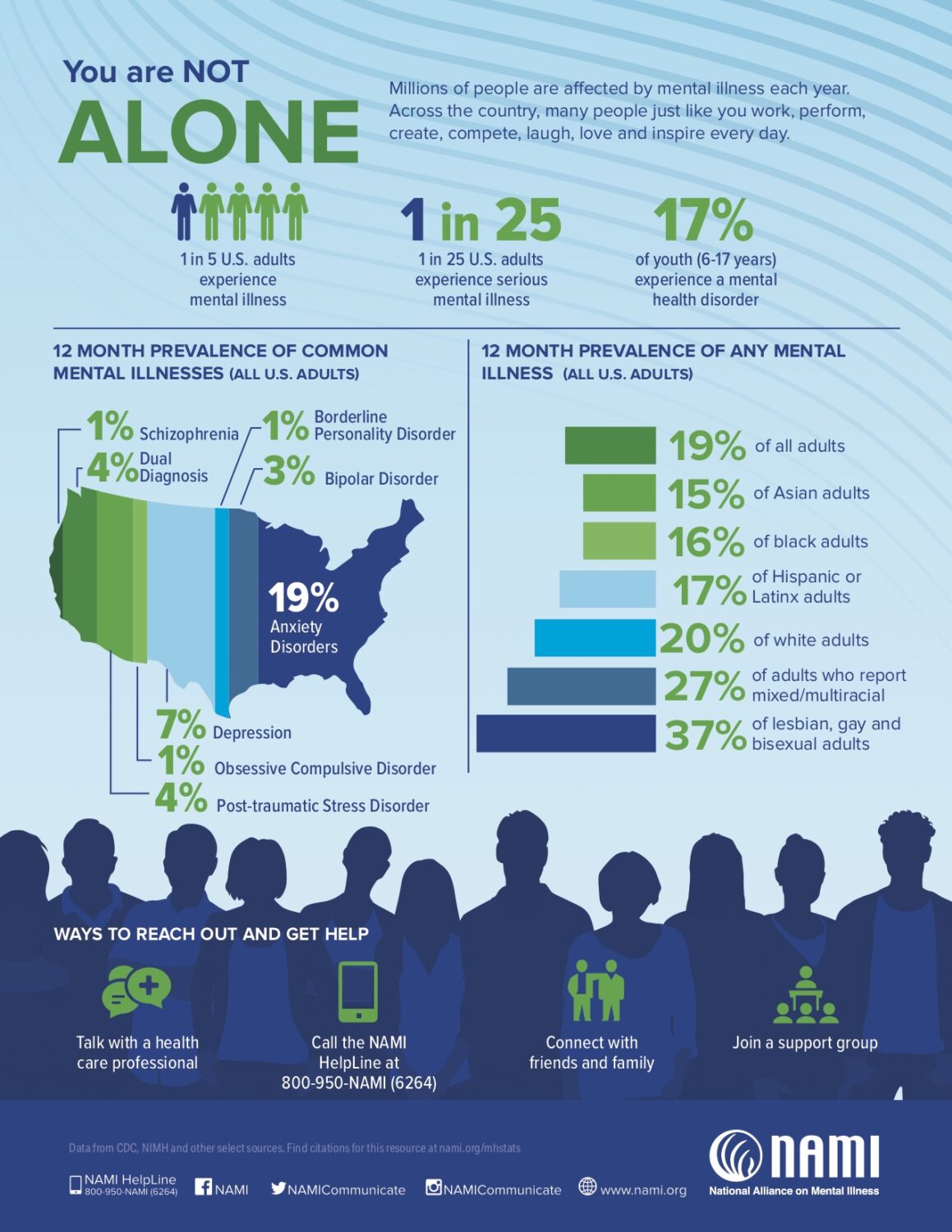As the springtime sun warms up our surroundings and breathes new life into the blooming flora, it’s the perfect time for us to turn our focus inwards and prioritize our own mental well-being. May is Mental Health Month, a time where the importance of mental health is not only acknowledged but actively embraced. It’s a time for change, healing, and growth, to celebrate resilience and advocate for increased understanding around mental health issues that countless individuals face every day.
Throughout this month, we’ll delve into the complexities of our emotions, unravel the threads that link our thoughts to our feelings, and explore various coping mechanisms designed to help one overcome the challenges of mental health. We’ll empower you with tools, resources, and stories of hope and inspiration—all in the pursuit of building a healthier and happier mindset.
So, as we embark on this journey together, let’s make it our collective mission to support one another, spread awareness, renew our commitment to self-care, and create a brighter future for our mental and emotional well-being. Because after all, there’s no better time than Mental Health Month to start healing from within.

1. Mental health crisis in the US
The mental health crisis in the United States has reached unprecedented levels, affecting individuals from all walks of life including adults, young people, and those from various socio-economic backgrounds. This crisis has stemmed from numerous factors, such as increased stress, isolation, and trauma resulting from the COVID-19 pandemic. Alarmingly, two in five adults report anxiety and depression, while a concerning number of teens experience persistent sadness or hopelessness. Furthermore, drug overdose deaths are near record highs, and suicide is the second leading cause of death among young people. Amidst these challenges, the Biden Administration is committed to addressing this pressing issue and helping millions of Americans overcome mental health struggles. [1][2]
2. Biden Administration’s commitment to address mental health crisis
The Biden Administration has shown a strong commitment to addressing the mental health crisis in the United States. Acknowledging the unprecedented mental health challenges faced by Americans of all ages, President Biden outlined a national mental health strategy during his first State of the Union address. This strategy aims to strengthen system capacity, connect more people to care, and create a continuum of support by transforming the nation’s health and social services infrastructure. With new investments in mental health programs and efforts to expand the behavioral health workforce, the administration is taking vital steps to ensure that everyone who needs help can access care when and where they seek it. [3][4]
3. HHS efforts to expand access to mental health services
The Department of Health and Human Services (HHS) has been diligently working to expand access to mental health services across the country. With a strong focus on community and youth programs, HHS has dedicated nearly $35 million in funding to strengthen community mental health services and suicide prevention programs. Through various grant programs, such as Project AWARE and the Garrett Lee Smith Campus Suicide Prevention initiative, HHS aims to develop sustainable infrastructure, enhance mental health services, and support early intervention strategies. Committed to helping young people thrive even during challenging times, HHS has consistently shown dedication to improving mental health access and support for all Americans. [5][6]
4. Proposed standards for access to quality health care in Medicaid and CHIP
The Centers for Medicare & Medicaid Services (CMS) has proposed new standards and requirements aimed at improving access to quality health care for beneficiaries of Medicaid and the Children’s Health Insurance Program (CHIP). If implemented, these rules would establish national standards for access to care, regardless of whether it is provided through managed care plans or directly by states through fee-for-service. The proposed changes include increased transparency for Medicaid payment rates to providers, appointment wait time standards for managed care enrollees, and state monitoring of network adequacy. Overall, the aim is to enhance the availability and quality of health care for millions of people, including children, pregnant individuals, older adults, and those with disabilities. [7][8] These changes are crucial for improving the healthcare system in our country. By increasing transparency in Medicaid payment rates, providers will have a better understanding of the financial aspects of their work and ultimately provide better care for their patients. Appointment wait time standards for managed care enrollees will ensure that patients receive timely access to necessary care. Additionally, state monitoring of network adequacy will ensure that patients have access to a variety of healthcare providers and services. These changes are especially important for vulnerable populations such as children, pregnant individuals, older adults, and those with disabilities, who often face significant barriers to accessing healthcare services. Overall, the proposed changes will greatly improve the quality and availability of healthcare for millions of people in need.
5. New Medicaid reentry demonstration opportunity for incarcerated individuals
The Centers for Medicare & Medicaid Services (CMS) has introduced a new Medicaid Reentry Section 1115 Demonstration Opportunity to help incarcerated individuals transition back to the community. This program allows state Medicaid programs to cover healthcare services for up to 90 days before an individual’s release, focusing on mental health, substance use disorders, and other chronic health conditions. This initiative aims to improve the reentry process for individuals by establishing connections with community healthcare providers. By expanding access to essential healthcare services, this demonstration shows promise for reducing hospital admissions, overdoses, and improving overall health outcomes for formerly incarcerated individuals as they reenter society. [9][10]

6. Surgeon General’s Framework for Workplace Mental Health and Wellbeing
The U.S. Surgeon General has introduced a framework to enhance mental health and wellbeing in the workplace. This initiative focuses on five essential human needs: protection from harm, connection and community, work-life harmony, mattering at work, and the opportunity for growth. It encourages employers to prioritize worker safety, promote positive social interactions, provide flexibility in work arrangements, foster an environment of respect and recognition, and create pathways for career advancement. By following this roadmap, organizations can support their employees’ mental health, leading to increased job satisfaction, productivity, and overall well-being. This groundbreaking move is a crucial step in addressing the mental health challenges faced by workers and their families nationwide. [11][12]
7. National Strategy to Support Family Caregivers
The U.S. Department of Health and Human Services has released the 2022 National Strategy to Support Family Caregivers, outlining nearly 350 actions to be taken by the federal government and more than 150 actions for other sectors. This much-needed strategy recognizes the indispensable role of family caregivers, as they provide the majority of long-term care in the United States. However, these caregivers often lack the resources to maintain their own health and financial stability. The 2022 National Strategy aims to build a comprehensive support system for family caregivers, addressing this crucial public health issue and ensuring a better quality of life for both caregivers and those they support. [13][14]

8. HHS Roadmap for Behavioral Health Integration
The HHS Roadmap for Behavioral Health Integration is a significant initiative by the U.S. Department of Health and Human Services (HHS) to address the growing mental health crisis in the country. Developed in response to the President’s Strategy to Address our National Mental Health Crisis, the roadmap seeks to integrate mental health and substance use disorder care into primary healthcare settings, ensuring accessible, equitable, evidence-based, and culturally sensitive services. By collaborating with various stakeholders, the HHS aims to improve the nation’s behavioral health services, especially during the ongoing COVID-19 pandemic, which has further exacerbated mental health challenges across all age groups. [15][16]

9. Impact of COVID-19 on mental health in the US
The COVID-19 pandemic has greatly impacted mental health in the United States, with stress, anxiety, and depression affecting millions of people. During the height of the pandemic in 2020 and 2021, anxiety and depression levels peaked, particularly among women and less educated men, while vaccination has improved mental health for some (source: PMC). Furthermore, job loss, isolation, grief, and financial instability associated with the pandemic have contributed to significant mental health challenges. A recent KFF/CNN survey revealed that around 3 in 10 adults (from a previous 4 in 10) continue to experience symptoms of anxiety and depression, highlighting the ongoing mental health crisis in the country. [17][18]

10. How to cope with stress during times of crisis.
During times of crisis, it is essential to learn and implement healthy coping strategies for managing stress. These may include taking breaks from continuous exposure to negative news, limiting screen time, and engaging in physical activities to maintain overall health. Consuming a well-balanced diet, getting sufficient sleep, and practicing mindfulness can also help alleviate stress. In addition, connecting with loved ones for emotional support and seeking professional help are vital steps to take. Participating in enjoyable hobbies and maintaining routines can also help individuals regain a sense of control during challenging times. Lastly, reaching out to community-based or faith-based organizations can provide further support and resources. [19][20]

